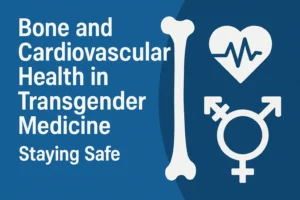
Discover the positive impact of estrogen therapy in HIV positive transgender women. Is it Safe for HIV Positive Transgender Women to be on Estrogen therapy? Learn about the benefits and considerations for hormonal therapy in this insightful blog post.
Transgender women who are HIV positive often face unique challenges and considerations when it comes to their healthcare. One area of concern is the use of hormone therapy, specifically estrogen therapy, which is commonly used for gender affirming purposes. This article aims to explore the safety of estrogen therapy for HIV positive transgender women. We will examine the existing research and guidelines on this topic, addressing potential drug interactions, side effects, and the overall impact on HIV management.
HIV and Estrogen Therapy: An Overview
The Importance of HIV Screening and Prevention
HIV screening and prevention are crucial for all individuals, including transgender women. According to national guidelines, all transgender persons should be screened for HIV at least once. Repeat screenings should be based on an individual’s risk assessment. Understanding the sexual history of transgender women is essential for effective risk assessment, including questions about both receptive and insertive intercourse. Prevention strategies, such as condom use, may be challenging for transgender women taking feminizing hormones, and alternative options should be explored.
Pre-Exposure Prophylaxis (PrEP)
Pre-exposure prophylaxis (PrEP) is a biomedical intervention that involves taking antiretroviral medication to prevent HIV acquisition. Studies have shown that daily oral PrEP with tenofovir disoproxil fumarate (TDF) and emtricitabine (FTC) can effectively reduce the risk of sexual HIV acquisition in various populations. While limited data is available specifically for transgender women, a sub-analysis of a large trial suggests that PrEP can be effective when taken as prescribed. However, adherence is crucial, as individuals who seroconverted had no detectable levels of TDF in their blood. Transgender women should be educated about the importance of PrEP and any potential drug interactions with their hormone therapy.
Non-Occupational Post-Exposure Prophylaxis (nPEP)
Non-occupational post-exposure prophylaxis (nPEP) is another prevention strategy that involves taking antiretroviral medication after potential exposure to HIV. The guidelines for nPEP in transgender people are similar to those for non-transgender individuals. However, social marketing and awareness campaigns should be tailored to transgender populations to increase awareness and accessibility.
Estrogen Therapy and HIV Management
Is it Safe for HIV Positive Transgender Women to be on Estrogen therapy
Hormone therapy for transgender women, including the use of estrogen, is not a contraindication for HIV treatment. In fact, providing hormone therapy in the context of HIV care may improve engagement, adherence, and viral load suppression. The World Health Organization and the U.S. Department of Health and Human Services recommend antiretroviral therapy for all individuals living with HIV, regardless of viral load or CD4 count. While there are potential drug-drug interactions between estrogen and certain ART agents, most ART can be safely used with estrogen. Exceptions include Amprenavir and unboosted fosamprenavir, which are not recommended for co-administration with estrogens although the data against these exceptions is not very strong however is best to avoid.
Metabolism and Drug Interactions
Estrogens are metabolized by the cytochrome P450 enzyme system, which can interact with ART agents. However, data on drug interactions between hormones and ART in the context of transgender care are limited. It is important to monitor estrogen levels and consider adjustments in hormone therapy or ART if necessary. Non-nucleoside reverse transcriptase inhibitors (NNRTIs), ritonavir-boosted protease inhibitors (PIs), or cobicistat with integrase strand inhibitors (INSTIs) may affect blood levels of hormonal contraceptive agents. Transgender women should be informed about potential interactions and encouraged to report any symptoms or side effects.
Hormone Therapy and Opportunistic Infections
Transgender women with HIV may require treatment or prophylaxis for opportunistic infections. It is essential to consider potential drug interactions when prescribing medications such as Trimethoprim-Sulfamethoxazole (TMP-SMX). There have been reports of hyperkalemia when spironolactone, commonly used in hormone therapy, is combined with TMP-SMX. Close monitoring of electrolytes and renal function is recommended when these medications are used together.
Conclusion
In conclusion, estrogen therapy for HIV positive transgender women can be safely integrated into their overall HIV management. It is crucial for healthcare providers to screen for HIV, assess risk, and provide appropriate prevention strategies tailored to transgender individuals. PrEP and nPEP can be effective in reducing the risk of HIV acquisition in this population. When it comes to hormone therapy, careful consideration of potential drug interactions and monitoring of hormone levels is necessary. Overall, a comprehensive and individualized approach to healthcare for HIV positive transgender women is essential to ensure their well-being and quality of life.








